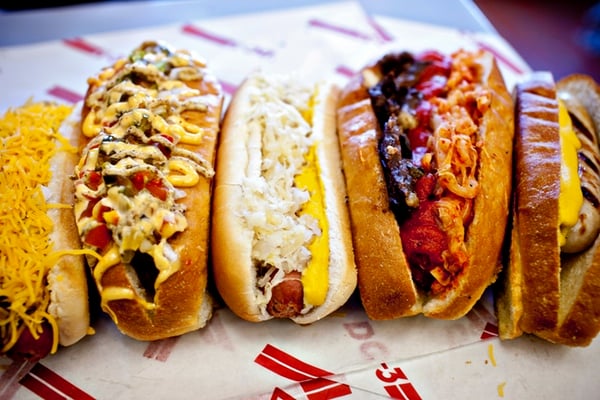Slideshow: Outtakes: Finding Washington's Best Hot Dogs
For much of the past decade, as burgers and pizzas emerged from their fast-food ghettos to become trendy fare embraced by restaurateurs, I kept wondering why that other fast-food staple, the hot dog, had yet to find a place on the local scene.
Who, after all, doesn’t love a good dog, plump and juicy, striped with spicy mustard and tucked into a warm bun? If burgers and pizzas could be lifted from their humble origins to become delivery systems for high-quality ingredients, why hadn’t the dog gone haute? In an age when butchering whole pigs and casing the off-cuts in fresh sausage is seen as evidence of an authentic aesthetic, shouldn’t the upscaling of the dog be imminent?
Yet as a slew of pizzerias and burger-only establishments opened over the past few years while restaurateurs hedged their recessionary bets, it was as if hot dogs had somehow been deemed too pedestrian to make the leap to gourmet. Even the food-truck craze has largely abandoned the dog, ditching its dependability for the sexiness of lobster rolls and bánh mì.
There are signs, however, that the hot dog may be finding favor at last. Several all-dog restaurants have made their debuts, and a number of name chefs have begun casing their own franks. I set out to sample them all.
In Chicago, a joint named Hot Doug’s may be more revered than either Charlie Trotter’s or Alinea, two of the country’s best restaurants. Chicagoans take their dogs seriously, Hot Doug’s more so than any other place in town. I don’t say that because it serves a foie-gras-topped hot dog. The foie gras isn’t evidence of a need to dazzle; it’s evidence of Hot Doug’s love of the form, its desire to come up with more ways to make a great thing even greater. This may be the finest example of the genre: the hot dog raised to high culinary art.
Like all great restaurants, Hot Doug’s makes it look easy. The two highest-profile dog houses in the Washington area, by contrast, destroy the hypothesis I brought with me to my investigations: that a hot dog place is all but a sure thing.
The folks behind Matchbox’s mini-burgers and pizzas have added to their portfolio a place called DC-3. Think of it as a glorified hot-dog stand. The uncomfortable chairs and chilly atmosphere drive home the message that you’re to get in and get out, and so do the dogs, which despite their snappy titles and beguiling combinations—the Bay Bridge is topped with Maryland crab dip and a shake of Old Bay—seldom justify their prices.
A recent stop-by for two people—four hot dogs, an order of crinkle fries, and two drinks—cost more than $30. The best of the bunch was a dog topped with Cincinnati chili and shredded cheese. It was also one of the simplest concoctions on the long menu. Most dogs were buried under a blitz of toppings or, worse, drowning in goopy, mayo-based sauces.
I wouldn’t seek out DC-3, and I probably won’t return to ChiDogO’s. You know a place isn’t good when it can’t produce a faithful version of its hometown classic. The tomatoes were tasteless, the celery salt was either missing or too sparingly applied, and the relish wasn’t the vivid green version Chicagoans know and love but the same jarred stuff we break out for barbecues and picnics.
I had hoped for a loving homage. But ChiDogO’s is best appreciated as a cover version of an original song—in this case, an off-key karaoke tune warbled by a drunk at a bar. You know what it’s supposed to be, but you don’t care to hear it again.
The place that makes me pine for Chicago is Windy City Red Hots—not because its dogs are so bad but because they’re so good. The operation was born out of desperation, according to owner Angel Miranda, a native Chicagoan whose cravings for hot dogs and Italian beef sandwiches had become a preoccupation. His homesickness led him to start a food truck, which is still parked most days outside a nursery in Ashburn. Last year, he opened the Leesburg storefront restaurant, his first.
Replicating the taste of his hometown dog isn’t that hard, Miranda says—it’s mostly a matter of shopping and assembly. He buys only Vienna beef dogs (most Chicago purveyors use Vienna) and gets his condiments from the same suppliers the dog joints in Chicago use. But shopping and assembly also require passion and knowledge, and Miranda has both.
Digging into his Chicago dog—with its deep-green relish, firm hit of celery salt, and poppyseed bun—transported me to a bleacher seat at Wrigley Field.
Windy City Red Hots earns an A for authenticity, but the dog house I find myself thinking about most is called Haute Dogs & Fries. Owners Pamela Swanson and Lionel Holmes don’t steam their dogs; they griddle them, which makes a big difference—the heat intensifies the taste of the meat and makes the pop of the casing more pronounced. Another big difference: They swab their split buns with butter, then lay them on the griddle to toast.
I’ve tried eight of the dogs there, and there isn’t one I didn’t like; most I loved. The simple ones, such as the Coney dog with house-made, long-simmered wiener sauce (a sort of soupy chili), are perfect, and the more complicated constructions never come off as contrived. There are even locally made sausages that double as dogs, including an excellent version made with Loudoun County’s Fields of Athenry lamb.
Haute Dogs is the best of the breed, but the fact that it’s in tiny Purcellville and not closer to DC tells you a lot about where the dog stands as a culinary totem. And while neither burgers nor pizzas lack for champions, no Peter Pastan (2 Amys), no Michael Landrum (Ray’s Hell-Burger), no Spike Mendelsohn (Good Stuff Eatery; We, the Pizza) has come forward to exploit the potential of a gourmet hot dog. Most of the chefs cranking out dogs appear content to dabble.
At Clarendon’s Lyon Hall, sausages are accorded a category of their own on chef Liam LaCivita’s Alsatian-influenced menu. But there’s only one hot dog, made from minced short ribs and zestily spiced.
At a recent meal in which my wife and son and I shared eight plates, my son’s hot dog was the best thing on the table. It can’t be good for business when a seven-buck hot dog is better than dishes commanding $20 or more.
It might sound ridiculous to say a hot dog is exquisite, but LaCivita’s short-rib dog has me tempted.
The Catahoula at Bayou Bakery was nearly as good. The beef franks are made for the restaurant by Jamie Stachowski, whose charcuterie has a devoted following of local chefs and farmers-market shoppers. Besides their rich, full flavor, what separates them from their mass-market cousins is their fine-grained texture. Bayou, true to the spirit of New Orleans, boils them in beer, slathers them with Creole mustard, then lays on a rich Vidalia-onion marmalade.
Diana Davila-Boldin, a Chicago native, has reproduced a lovingly authentic version of her hometown dog at Sidebar, the cocktail bar/pool hall adjacent to the restaurant Jackie’s, where Davila-Boldin is the chef. The Vienna-beef dog pops, as it should, and the accoutrements, including tomato chunks, sport peppers, and a few dabs of electric-green relish, are bright-tasting and crisp.
At PS 7’s, the dogs have earned a place on the regular menu. Deservedly so—they’re the best thing here. Some artists prefer to work small, the better to perfect a vision, and so it seems to be with chef Peter Smith’s miniaturized hot dogs. With their glistening, golden-brown buns and perfectly formed franks, they look painted, or engineered—like something from a child’s kitchen-stove set.
Notice a pattern here? Talented chefs cranking out charcuterie in the form of a frank, or using their advanced skills to elevate a simple snack.
As someone who’s always had misgivings about the idea of trained chefs devoting so much time and attention to perfecting French fries—isn’t that best left to teenagers at the fast-food fryer?—I never imagined I’d come to embrace haute junk food.
But my investigations didn’t occur in isolation. They were fit around visits to some of the area’s best restaurants. Many days I followed up a hot-dog lunch with a fine-dining dinner. Sometimes I finished a three-course dinner, then got in my car and drove out for a hot dog. One night I ate a dog before dinner, met friends for Thai food, then grabbed a dog on the way home. The evening of consumption didn’t end there; it ended with an Alka-Seltzer.
One day as I was reviewing a pile of receipts and reliving two months of restaurant meals, it occurred to me: Those hot
dogs were some of the best things I ate.
A restaurant is in the business of making memories, right? If it’s French fries or burgers or hot dogs, so be it. I’d rather eat junk food prepared with love and conviction than a mediocre pot of rillettes.
As to why burgers and pizzas have become fixtures of restaurant menus while hot dogs remain on the margins, I’m no more enlightened than I was when I began.
Even Peter Smith of PS 7’s, one of the first chefs to feature a hot dog, presents his miniaturized versions almost as a novelty item. Smith is an eclectic, restless cook; experimentation and cleverness often take precedence over simplicity and satisfaction. That’s one reason I prefer the lounge at PS 7’s, where flatbreads and burgers predominate, to the dining room. When he eases up on his impulse to dazzle, to reinvent a classic, he finds his mark nearly every time.
I think he’d be wise to build more of his menu around his dogs. They might inspire a new aesthetic. Better yet, he could open a hot-dog joint.
This article appears in the April 2011 issue of The Washingtonian.


















